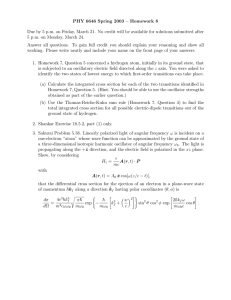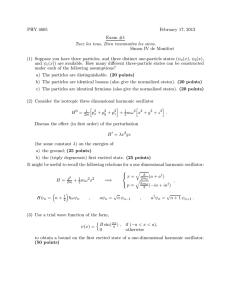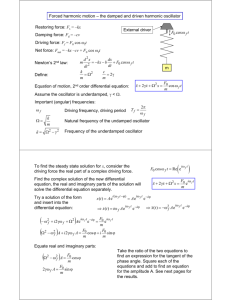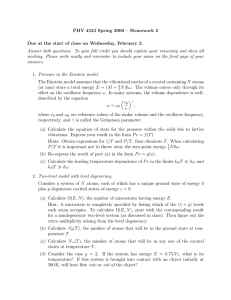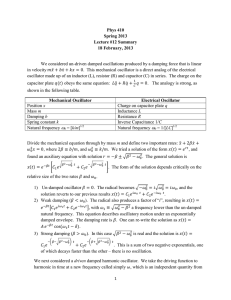(1)
advertisement
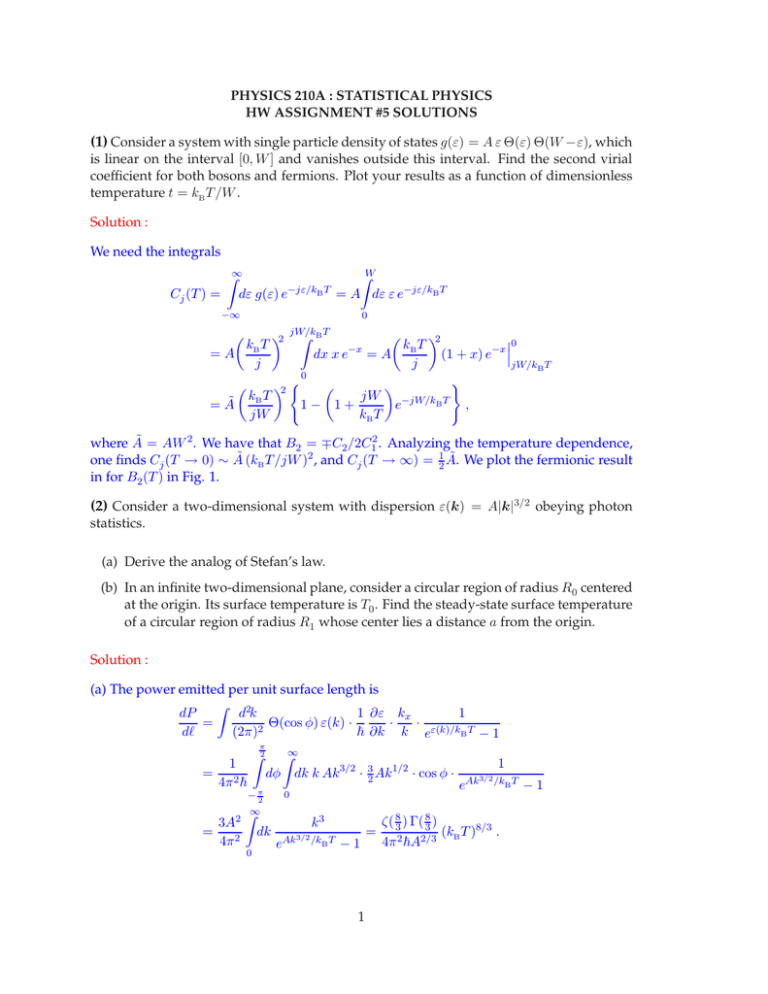
PHYSICS 210A : STATISTICAL PHYSICS
HW ASSIGNMENT #5 SOLUTIONS
(1) Consider a system with single particle density of states g(ε) = A ε Θ(ε) Θ(W −ε), which
is linear on the interval [0, W ] and vanishes outside this interval. Find the second virial
coefficient for both bosons and fermions. Plot your results as a function of dimensionless
temperature t = kB T /W .
Solution :
We need the integrals
ZW
Z∞
−jε/kB T
= A dε ε e−jε/kB T
Cj (T ) = dε g(ε) e
0
−∞
jW/k
Z BT
kB T 2
=A
j
0
kB T 2
(1 + x) e−x dx x e = A
j
jW/kB T
0
)
(
jW
kB T 2
1− 1+
e−jW/kBT ,
= Ã
jW
kB T
−x
where à = AW 2 . We have that B2 = ∓C2 /2C12 . Analyzing the temperature dependence,
one finds Cj (T → 0) ∼ Ã (kB T /jW )2 , and Cj (T → ∞) = 12 Ã. We plot the fermionic result
in for B2 (T ) in Fig. 1.
(2) Consider a two-dimensional system with dispersion ε(k) = A|k|3/2 obeying photon
statistics.
(a) Derive the analog of Stefan’s law.
(b) In an infinite two-dimensional plane, consider a circular region of radius R0 centered
at the origin. Its surface temperature is T0 . Find the steady-state surface temperature
of a circular region of radius R1 whose center lies a distance a from the origin.
Solution :
(a) The power emitted per unit surface length is
Z
dP
d2k
1 ∂ε kx
1
=
Θ(cos φ) ε(k) ·
·
·
dℓ
(2π)2
~ ∂k k eε(k)/kB T − 1
π
1
= 2
4π ~
3A2
=
4π 2
Z2
− π2
Z∞
dφ dk k Ak3/2 · 32 Ak1/2 · cos φ ·
Z∞
dk
0
0
k3
eAk
3/2 /k
BT
−1
1
=
1
3/2
eAk /kB T
ζ( 83 ) Γ( 38 )
(k T )8/3 .
4π 2 ~A2/3 B
−1
Figure 1: Fermionic second virial coefficient B2 (T ) for problem 1.
Here we have used
Z∞
dx
xt
= Γ(t + 1) ζ(t + 1) .
ex − 1
0
Thus,
dP
= σT 8/3 ,
dℓ
where
8/3
ζ( 8 ) Γ( 8 )kB
σ = 3 2 3 2/3
4π ~A
is the analog of Stefan’s law for this system.
8/3
(b) The total power emitted by the object at temperature T0 is P = σT0 · 2πR0 . Of
this, a fraction (2R1 )/(2πa) is incident upon the second object, which is to say the angle
8/3
subtended divided by 2π. The second object radiates total power σT1 · 2πR1 . Thus,
in steady state, where the power absorbed by the second object is equal to the power it
radiates, we have
3/8
R0
T1 =
T0 .
πa
Note that the result is independent of the radius R1 .
(3) Consider an infinite linear chain of identical atoms described by the potential energy
function
U=
∞
X
1
K(n
4
n,n′ =−∞
− n′ ) un − un′
2
,
where K(n − n′ ) = K(n′ − n) depends only on the relative distance |n − n′ |. Find the
phonon dispersion and examine its long wavelength limit. Show that if K(m) ∝ |m|−p for
large |m| then the long-wavelength dispersion in the vicinity of the zone center k = 0 is
linear in the crystal momentum k if p > 3 but for 1 < p < 3 one has ω(k) ∝ |k|(p−1)/2 .
2
Solution :
Each unique (n, n′ ) pair occurs twice in the potential energy sum, hence we can write
X
2
K(j − j ′ ) uj − uj ′ ,
U = 12
j<j ′
When we differentiate with respect to un to find the corresponding force, we note that
there are two possibilities: (i) j = n and the remaining sum is over all j ′ > n, and (ii) j ′ = n
and the remaining sum is over all j < n. The equation of motion is therefore
X
X
mün = −
K(n − n′ ) (un − un′ ) = −
K(l) (un − un−l ) .
l
n′
Now Fourier transform, with
ûk =
X
un e−ikn
,
un =
n
1 X
ûk eikn ,
N
k
with eikN = 1 for a ring with N sites. For an infinite chain, take N → ∞, in which case
Rπ dk
1 P
→
k
N
2π . We then have
−π
¨ = K̂(0) − K̂(k) u ,
mû
k
k
where
K̂(k) =
∞
X
K(l) e−ikl .
l=−∞
¨ = −ω 2 û , with
Thus, we have û
k
k k
ωk2 =
∞
2 X
K(l) 1 − cos(kl) ,
m
l=1
where we have used K(l) = K(−l). For k → 0, we expand the cosine, and we have
ωk2 =
∞
2k2 X
K(l) l2 + . . .
m
l=1
If the sum converges, then ωk = c|k| at long wavelengths, with c2 = m−1
requires |K(l)| ∝ |l|−p with p > 3 for large |l|.
P
l
K(l) l2 . This
If 1 < p < 3, divide the sum into two parts, the first from l = 1 to l = l0 − 1 and the second
from l = l0 to l = ∞. We focus on the first part. Let us take l0 ∼ k−1 , with k → 0. Then
l0 −1
2
X
l=1
l −1
0
X
K(l) 1 − cos(kl) = k2
K(l) l2 ≈ Ak2 + O kp+1 .
l=1
3
Pl0 −1 2−p
l .
Here we have assumed K(l) ∝ l−p for large l, and we have analyzed the sum l=1
For p > 1, the first term on the RHS dominates in the k → 0 limit. Next we have the second
term,
Z∞
Z∞
∞
X
1 − cos(kl)
1 − cos u
p−1
K(l) 1 − cos(kl) ∼ B dl
2
= Bk
.
du
p
l
up
l=l0
l0
kl0
With kl0 ∼ 1, the integral is a finite constant. Thus, ωk2 ∼ Ak2 + B|k|p−1 for 1 < k < 3, and
the second term dominates as k → 0, i.e. ωk ∝ |k|(p−1)/2 .
1
2
(4) Consider a set of N noninteracting S =
fermions in a one-dimensional harmonic
oscillator potential. The oscillator frequency is ω. For kB T ≪ ~ω, find the lowest order
nontrivial contribution to the heat capacity C(T ), using the ordinary canonical ensemble.
The calculation depends on whether N is even or odd, so be careful! Then repeat your
calculation for S = 32 .
Solution :
The partition function is given by
Z = g0 e−βE0 + g1 E −βE1 + . . . ,
where gj and Ej are the degeneracy and energy of the j th energy level, respectively. From
this, we have
F = −kB T ln Z = E0 − kB T ln g0 + g1 e−∆1 /kB T + . . . ,
where ∆j ≡ Ej − E0 is the excitation energy for energy level j > 1. Suppose that the
spacings between consecutive energy levels are much larger than the temperature, i.e.
Ej+1 − Ej ≫ kB T . This is the case for any harmonic oscillator system so long as ~ω ≫ kB T ,
where ω is the oscillator frequency. We then have
F = E0 − kB T ln g0 −
g1
k T e−∆1 /kB T + . . .
g0 B
The entropy is
S=−
g ∆
∂F
g
= ln g0 + 1 e−∆1 /kB T + 1 1 e−∆1 /kB T + . . .
∂T
g0
g0 T
and thus the heat capacity is
C(T ) = T
∂S
g ∆21 −∆1 /k T
B
= 1
e
+ ...
∂T
g0 kB T 2
With g0 = g1 = 1, this recovers what we found in §4.10.6 of the Lecture Notes for the low
temperature behavior of the Schottky two level system.
OK, so now let us consider the problem at hand, which is the one-dimensional harmonic
oscillator, whose energy levels lie at Ej = (j + 21 )~ω, hence ∆j = j~ω is the j th excitation
4
g0 = 1
...
...
...
...
...
...
N even :
g1 = 2
g0 = 2
...
...
...
...
...
...
...
...
...
...
...
...
N odd :
g1 = 4
Figure 2: Ground states and first excited states for the S =
harmonic oscillator.
1
2
one-dimensional simple
N is even, the ground state is
energy. For S = 21 , each level is twofold degenerate. When
unique, and we occupy states | j , ↑ i and | j , ↓ i for j ∈ 0 , . . . , N2 −1 . Thus, the ground
state is nondegenerate and g0 = 1. The lowest energy excited states are then made, at fixed
total particle number N , by promoting either of the | j = N2 −1 , σ i levels (σ =↑ or ↓) to
j = N2 . There are g1 = 2 ways to do this, each of which increases the energy by ∆1 = ~ω.
When N is odd, we fill one of the spin species up to level j = N 2−1 and the other up to level
j = N 2+1 . In this case g0 = 2. What about the excited states? It turns out that g1 = 4, as
can be seen from the diagrams in Fig. 2. For N odd, in either of the two ground states, the
highest occupied oscillator level is j = N 2+1 , which is only half-occupied with one of the
two spin species. To make an excited state, one can either (i) promote the occupied state to
the next oscillator level j = N 2+3 , or (ii) fill the unoccupied state by promoting the occupied
state from the j = N 2−1 level. So g1 = 2 · 2 = 4. Thus, for either possibility regarding the
parity of N , we have g1 /g0 = 2, which means
C(T ) =
2(~ω)2 −~ω/k T
B
e
+ ...
kB T 2
This result is valid for N > 1.
An exception occurs when N = 1, where the lone particle is in the n = 0 oscillator level.
Since there is no n = −1 level, the excited state degeneracy is then g1 = 2, and the heat
capacity is half the above value. Of course, for N = 0 we have C = 0.
5
excited
state
...
...
...
excited
state
...
...
...
ground
state
...
...
...
Figure 3: Ground states and first excited states for the general S case, with K = 2S +1.
What happens for general spin S? Now each oscillator level has a K ≡ 2S +1 spin degeneracy. We may write N = rK + s, where r and s are integers and s ∈ {0 , 1 , . . . , K −1}.
The ground states are formed by fully occupying all | j , m i states, with m ∈ {1, . . . , K},
from j = 0 to j = r −1. The remaining
s particles must all be placed in the K degenerate
K
levels at j = r, and there are s ways of achieving this. Thus, g0 = Ks .
Now consider the excited states. We first assume r > 0. There are then two ways to make
an excited state. If s > 0, we can promote one of the s occupied states with j = r to the
next oscillator level j = r + 1. One then has s − 1 of the K states with j = r occupied,
and one
with j = r +1 occupied. The degeneracy for this configuration is
ofK the
K states
K g= K
=
K
.
1 s−1
s−1 Another possibility is to promote one of the filled j = r−1 levels
to the j = r level, resulting in K − 1 occupied states with j = r − 1 and s + 1 occupied
states with j = r. This is
possible for any
allowed value of s. The degeneracy of this
K K K configuration is g = K−1
=
K
.
Thus,
s+1
s+1
g1 = K
K
K
+K
,
s+1
s−1
and thus for r > 0 and s > 0 we have
~ω 2 −~ω/k T
g1
B
k
e
+ ...
C(T ) =
g0 B kB T
K −s
s
~ω 2 −~ω/k T
B
=K·
e
+ ...
+
· kB
s+1
K −s+1
kB T
6
The situation is depicted in Fig. 3. Upon reflection, it becomes clear that this expression
is also valid for s = 0, since the second term in the curly brackets in the above equation,
which should be absent, yields zero anyway.
The exceptional cases occur when r = 0, in which case there is no j = r − 1 level to
K
depopulate. In this case, g1 = K s−1
and g1 /g0 = Ks/(K − s + 1). Note that all our results
are consistent with the K = 2 case studied earlier.
7

